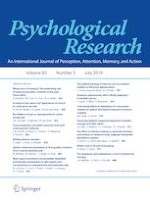15-09-2017 | Original Article
The implicit learning of metrical and non-metrical rhythms in blind and sighted adults
Gepubliceerd in: Psychological Research | Uitgave 5/2019
Log in om toegang te krijgenAbstract
Forming temporal expectancies plays a crucial role in our survival as it allows us to identify the occurrence of temporal deviants that might signal potential dangers. The dynamic attending theory suggests that temporal expectancies are formed more readily for rhythms that imply a beat (i.e., metrical rhythms) compared to those that do not (i.e., nonmetrical rhythms). Moreover, metrical frameworks can be used to detect temporal deviants. Although several studies have demonstrated that congenital or early blindness correlates with modality-specific neural changes that reflect compensatory mechanisms, few have examined whether blind individuals show a learning advantage for auditory rhythms and whether learning can occur unintentionally and without awareness, that is, implicitly. We compared blind to sighted controls in their ability to implicitly learn metrical and nonmetrical auditory rhythms. We reasoned that the loss of sight in blindness might lead to improved sensitivity to rhythms and predicted that the blind learn rhythms more readily than the sighted. We further hypothesized that metrical rhythms are learned more readily than nonmetrical rhythms. Results partially confirmed our predictions; the blind group learned nonmetrical rhythms more readily than the sighted group but the blind group learned metrical rhythms less readily than the sighted group. Only the sighted group learned metrical rhythms more readily than nonmetrical rhythms. The blind group demonstrated awareness of the nonmetrical rhythms while learning was implicit for all other conditions. Findings suggest that improved deviant-sensitivity might have provided the blind group a learning advantage for nonmetrical rhythms. Future research could explore the plastic changes that affect deviance-detection and stimulus-specific adaptation in blindness.
